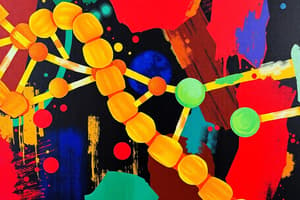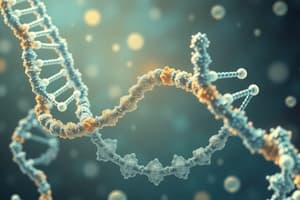Podcast
Questions and Answers
What distinguishes structural isomers from other types of isomers?
What distinguishes structural isomers from other types of isomers?
- They exhibit the same chemical properties.
- They have different molecular formulas.
- They involve the same atoms in different arrangements. (correct)
- They have different functional groups.
What is a defining characteristic of geometric isomers?
What is a defining characteristic of geometric isomers?
- They have the same covalent arrangements but different spatial orientations. (correct)
- They do not contain double bonds.
- They differ in the number of atoms.
- They involve mirror image arrangements of atoms.
Which statement about enantiomers is true?
Which statement about enantiomers is true?
- Both enantiomers exhibit the same biological activity.
- They can have identical physical properties.
- They must contain a carbon atom with four different substituents. (correct)
- One enantiomer is always more stable than the other.
Why are fats considered hydrophobic substances?
Why are fats considered hydrophobic substances?
In the biochemistry of vision, what happens to rhodopsin?
In the biochemistry of vision, what happens to rhodopsin?
What was the effect of one enantiomer of the drug thalidomide?
What was the effect of one enantiomer of the drug thalidomide?
Which type of isomer involves mirror images?
Which type of isomer involves mirror images?
What is the primary element that serves as the backbone of biological molecules?
What is the primary element that serves as the backbone of biological molecules?
Which of the following compounds is an example of structural isomerism?
Which of the following compounds is an example of structural isomerism?
Which of the following best describes organic chemistry?
Which of the following best describes organic chemistry?
What element is commonly found bonded to carbon in biological molecules?
What element is commonly found bonded to carbon in biological molecules?
Why are organic compounds able to form a vast variety of molecules?
Why are organic compounds able to form a vast variety of molecules?
How do variations in organic molecules relate to living things?
How do variations in organic molecules relate to living things?
What is the composition of the majority of biological molecules?
What is the composition of the majority of biological molecules?
What did early organic chemists initially focus on?
What did early organic chemists initially focus on?
Which of the following compounds represents a simple organic molecule?
Which of the following compounds represents a simple organic molecule?
What is the primary function of fats in organisms?
What is the primary function of fats in organisms?
How do animals benefit from storing energy as fats instead of polysaccharides?
How do animals benefit from storing energy as fats instead of polysaccharides?
What component of phospholipids is typically responsible for their hydrophilic nature?
What component of phospholipids is typically responsible for their hydrophilic nature?
What structural arrangement do phospholipids form when they are added to water?
What structural arrangement do phospholipids form when they are added to water?
What role does adipose tissue play in addition to energy storage?
What role does adipose tissue play in addition to energy storage?
Which of the following best describes how phospholipids are arranged at the cell membrane?
Which of the following best describes how phospholipids are arranged at the cell membrane?
Why do plants use oils instead of starch for energy storage in seeds?
Why do plants use oils instead of starch for energy storage in seeds?
What is a key characteristic of the fatty acid tails in phospholipids?
What is a key characteristic of the fatty acid tails in phospholipids?
Which of the following nitrogenous bases is a pyrimidine?
Which of the following nitrogenous bases is a pyrimidine?
What is the key difference between ribose and deoxyribose?
What is the key difference between ribose and deoxyribose?
What forms the backbone of a polynucleotide?
What forms the backbone of a polynucleotide?
What does the 5' end of a nucleic acid molecule contain?
What does the 5' end of a nucleic acid molecule contain?
How are adjacent nucleotides in a polynucleotide chain joined?
How are adjacent nucleotides in a polynucleotide chain joined?
What is a nucleoside composed of?
What is a nucleoside composed of?
What determines the primary structure of a protein?
What determines the primary structure of a protein?
Which of the following statements about RNA is true?
Which of the following statements about RNA is true?
What typically causes proteins to denature when transferred to an organic solvent?
What typically causes proteins to denature when transferred to an organic solvent?
Which factor can lead to the denaturation of proteins, potentially causing high fevers to be fatal?
Which factor can lead to the denaturation of proteins, potentially causing high fevers to be fatal?
What role do chaperonins play in protein folding?
What role do chaperonins play in protein folding?
What technique is commonly used to determine the conformation of a protein?
What technique is commonly used to determine the conformation of a protein?
Which statement about the prediction of protein conformation is true?
Which statement about the prediction of protein conformation is true?
What is the primary difference between RNA and DNA?
What is the primary difference between RNA and DNA?
What is the significance of understanding a protein’s sequence in biochemistry?
What is the significance of understanding a protein’s sequence in biochemistry?
Which of the following statements about protein folding is correct?
Which of the following statements about protein folding is correct?
Flashcards are hidden until you start studying
Study Notes
Nitrogenous Bases and Their Structure
- Three pyrimidines: cytosine (C), thymine (T), uracil (U).
- Two purines: adenine (A), guanine (G); has a six-membered ring fused to a five-membered ring.
- RNA contains ribose sugar; DNA contains deoxyribose, differing by one oxygen atom at carbon two.
- Sugar atoms in nucleotides are labeled with a prime notation (e.g., 2' for the second carbon).
- Nucleoside formed by the combination of a nitrogenous base and a pentose sugar.
- Nucleotide formed when a phosphate group is added to a nucleoside.
Polynucleotides and Gene Information
- Polynucleotides linked by phosphodiester bonds between the 3’ hydroxyl group of one nucleotide and the 5’ phosphate of another.
- A sugar-phosphate backbone with nitrogenous base appendages forms the structure of DNA and RNA.
- DNA and RNA have distinct ends: 5’ end with a phosphate group and 3’ end with a hydroxyl group.
- Unique sequences of bases in DNA/mRNA dictate the primary structure of proteins and determine their function.
Carbon and Molecular Diversity of Life
- Cells are primarily composed of carbon-based compounds, despite being 70-95% water.
- Carbon's ability to bond with various elements enables the creation of diverse biological molecules, including proteins and nucleic acids.
- Major elements: carbon (C), hydrogen (H), oxygen (O), nitrogen (N), sulfur (S), phosphorus (P).
Organic Chemistry and Structural Variations
- Organic chemistry focuses on carbon compounds, which range from simple molecules like CO2 to complex proteins.
- Isomers have the same molecular formula but different structures, affecting their chemical properties.
- Structural isomers differ in covalent arrangements; geometric isomers differ in spatial arrangements around double bonds.
- Enantiomers are mirror images and may have different biological activities, one often being active and the other inactive.
Function and Storage of Fats
- Fats serve mainly for energy storage; they store more energy per gram than carbohydrates.
- Adipose tissue cushions organs and provides insulation; humans store long-term energy in adipose cells.
- Phospholipids are crucial components of cell membranes, composed of two fatty acids, glycerol, and a phosphate group.
Membrane Structure
- Phospholipids naturally self-assemble in water, forming micelles with hydrophobic tails inward and hydrophilic heads outward.
- In cell membranes, phospholipids arrange as a bilayer, providing a barrier to the external environment.
Protein Structure and Function
- Proteins may denature due to harsh conditions (like heat), affecting their functionalities.
- Chaperonin proteins assist in correct folding of polypeptides, not specifying final structures but protecting and segregating them.
- X-ray crystallography and nuclear magnetic resonance (NMR) spectroscopy are methods used to determine protein structures.
Nucleic Acids and Heredity
- DNA is the hereditary material and encodes the amino acid sequence of proteins through genes.
- Two nucleic acid types: RNA (a single polynucleotide chain) and DNA (double helix structure).
Studying That Suits You
Use AI to generate personalized quizzes and flashcards to suit your learning preferences.





